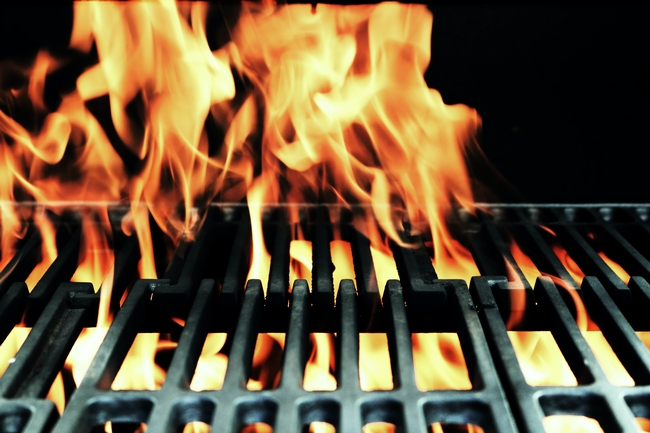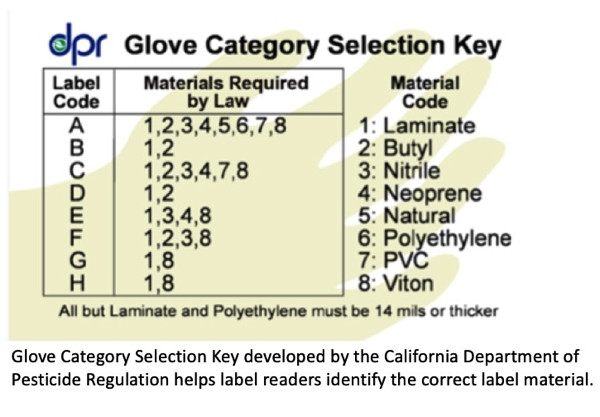
Posts Tagged: safety
Trees Can Hurt
Pruning trees is dangerous. You think you know which way that branch is going to drop, and instead it falls right on your head. Good thing you are wearing a helmet, but a big limb is not going to be stopped by a helmet. A recent report out of Penn State developed some statistics on tree “felling' – pruning – which should be noted by anyone cutting trees. https://onlinelibrary.wiley.com/doi/10.1002/ajim.23286 . Where it reads “logging and landscaping”, read avocado pruning. These statistics are just for deaths from trees, not injuries. I couldn't find on-farm statistics of pruning injuries, but, know that farming is one of those high risk activities like other tree-related interactions.
Tree felling — whether by professional loggers in a forest setting or by landscapers in urban and rural landscapes — is the most dangerous job in what are two of the most dangerous industries, according to Penn State researchers who conducted a new study of associated deaths.
The Occupational Safety and Health Administration calls logging “the most dangerous occupation in the United States.” The fatal injury rate for loggers is more than 30 times the rate for all U.S. workers. Tree-care workers also encounter hazards at rates much higher than the average employee.
“This was the first research to look at commercial logging and landscaping services together,” said Judd Michael, Nationwide Insurance Professor of Agricultural Safety and Health and professor of agricultural and biological engineering, College of Agricultural Sciences. “It was a unique and more accurate way to assess fatalities. The commonality, of course, is that workers in both fields fell trees. They do it using very different methods, but either way, it is extremely hazardous work.”
Logging in Appalachia and other regions with forests growing on rough, mountainous terrain continues largely unmechanized, with workers felling trees with chainsaws, standing at their bases; landscapers, on the other hand — because they must control the fall of limbs and trunks — must climb trees with chainsaws and cut sections down.
To reach their conclusions, the researchers analyzed an Occupational Safety and Health Administration database to identify occupational tree-felling fatalities in the United States during a 10-year period — from 2010 through the first half of 2020. They compared data for the two industry segments of logging and landscaping services.
In findings recently published in the American Journal of Industrial Medicine, the researchers reported that there were 314 fatalities over the period. The victims were overwhelmingly male, with the median age being 43. “Struck-by” was the No. 1 event type causing fatalities, with the head being the most frequent body part involved in fatalities.
Falls from elevation was the only event type significantly different between the logging and landscaping industries, Michael noted, adding “but you would expect that, given the nature of the work.” Poor decision-making was listed as a key component of fatal incidents, and in some cases bystanders were fatally injured due to the actions of others.
The number of tree-felling fatalities varied greatly from year to year during the study, and there were no clear trends in fatality rates, Michael pointed out. The reasons for the cyclical rise and fall of tree-felling fatalities are unknown but he suspects they may be driven by weather events. One possible causal factor was whether hurricanes made landfall in the coastal states.
Storm damage may lead to increased fatalities, he explained. Years such as 2012, 2017 and 2018 with abnormally high damage costs from Atlantic storms also saw relatively high numbers of landscaping fatalities that could be associated with storm?damaged urban trees, while 2014 and 2015 had very quiet hurricane seasons and relatively few fatalities.
“Look at what happened with Hurricane Ida recently, with all the power lines that were down because of downed trees in Louisiana,” he said. “We don't know yet if that will lead to landscape tree-feller deaths, but we suspect large storms lead to more fatalities. Utilities can't restore power without clearing downed trees, so the importance of keeping tree operations safe can't be overstated.”
Getting a better handle on fatality numbers is just an early step in trying to make the job of tree fellers safer, Michael explained. And it is not as simple as just advising that protective equipment should be worn.
“Personal protective equipment is mandated, but that means a hard hat or some chaps on a worker's legs to stop a saw from cutting through,” he said. “But if you have a 1,000-pound limb falling from 10 feet or 50 feet, no equipment is going to protect them. And that's one of our key takeaways — you can have all the protection you want, but it won't help you if you get hit by a tree trunk or large limb. That's why we need to have better decision-making to keep people out of danger.”
There is a need to focus on hazards associated with tree-felling activities so that proactive prevention strategies can be developed, Michael suggested.
“Employers in the landscaping industry should put extra emphasis on fall protection and prevention for those working in elevated positions,” he said. “Greater attention to falling object avoidance for persons working around a tree being felled could also prevent fatalities. Logging companies should strive to adopt mechanized methods for tree felling.”
But fatalities from tree felling are just a fraction of the number of severe injuries incurred while working around trees, Michael added. By focusing on the cause of fatalities, Penn State researchers hope that strategies can be developed to also reduce the number of injuries in these important industries.
More Information on safely working trees:
https://www.dir.ca.gov/dosh/dosh_publications/Ag-Field-Operations.pdf
https://www.safeatworkca.com/safety-articles/tree-trimming/
https://www.dir.ca.gov/dosh/tree-work-safety.html
https://www.safeatworkca.com/safety-articles/cutting-down-trees/
And KEEP those TOOLS SHARP: https://ucanr.edu/blogs/blogcore/postdetail.cfm?postnum=28916
This map shows the locations of tree-felling fatalities, 2010–2020.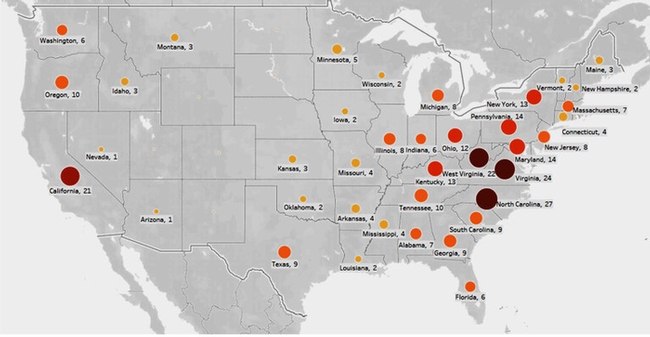
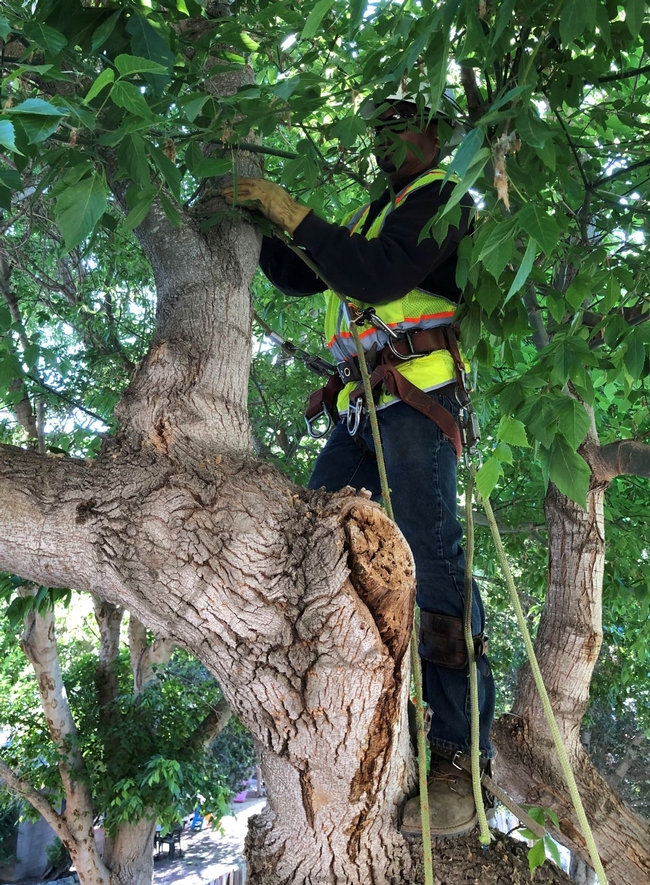
pruning tree 3
Summer safety: Tips to avoid foodborne and heat illnesses
Happy summer! It's time to get the barbecue grilling and the pool party started. To keep your summer healthy and fun, UC ANR offers some important safety tips.
Food safety
Food poisoning is a serious health threat in the United States, especially during the hot summer months. According to the Centers for Disease Control and Prevention (CDC), 1 in 6 Americans suffer from a foodborne illness each year, resulting in thousands of hospitalizations and 3,000 deaths.
Both the CDC and U.S. Department of Agriculture (USDA) suggest four key rules to follow to stay food safe:
- Clean: Clean kitchen surfaces, utensils, and hands with soap and water while preparing food. Wash fresh fruits and vegetables thoroughly under running water.
- Separate: Separate raw meats from other foods by using different cutting boards. And be sure to keep raw meat, poultry, seafood and eggs away from other items in your refrigerator.
- Cook: Cook foods to the right temperature; be sure to check internal temperature by using a food thermometer.
- Chill: Chill raw and prepared foods promptly.
Here are some additional tips from the USDA. Be sure to check out the CDC's comprehensive food safety website, which also has materials in both Spanish and English. For food safety tips in real time, follow USDA Food Safety on Twitter.
Summer also means more outside grilling, which can pose unique food safety concerns. Before firing up the barbecue, check out these five easy tips from UC Davis.
Handling food safety on the road
Before you take off on a road trip, camping adventure or boating excursion, don't forget to consider food safety. You'll need to plan ahead and invest in a good cooler.
Remember, warns the USDA, don't let food sit out for more than one hour in temperatures above 90 degrees F. And discard any food left out more than two hours; after only one hour in temperatures above 90 degrees F.
If there are any doubts about how long the food was out, it is best to throw it out!
Get more food safety tips for traveling from the USDA.
Avoid heat illness
“Summer can be a time for fun and relaxation, but in warm climates, we need to stay aware of the signs of heat illness and help keep our family members and co-workers safe,” says Brian Oatman, director of Risk & Safety Services at UC ANR.
“UC ANR provides comprehensive resources on our website, but it's designed around California requirements for workplace safety.” But, Oatman notes, much of the information applies.
“The training and basic guidance – drink water, take a rest when you are feeling any symptoms and having a shaded area available – are useful for anyone at any time.”
To increase your awareness of heat illness symptoms – and to learn more about prevention – Oatman suggests a few resources.
“Our Heat Illness Prevention page has many resources, including links for training, heat illness prevention plans, and links to other sites. One of the external sites for heat illness that I recommend is the Cal/OSHA site, which spells out the basic requirements for heat illness prevention in the workplace. It's also available in Spanish."
For those on the go, Oatman also recommends the National Institute for Occupational Safety and Health (NIOSH) mobile heat safety app.
Fire Resources
Current fire activity in Ventura County reminds us that fire season is here. It's critical to be prepared. Here are some important resources to help you get ready and stay apprised of fire activity in Ventura County.
For the latest fire incident information, visit the Ventura County Fire Department website. This website also contains a wildfire action plan for farmers, ranchers and growers.
We also suggest you bookmark the VC Emergency portal. You can access the Ventura County Emergency Preparedness Guide in English and Spanish.
Here are other resources we recommend:
- Fire in California This is UC ANR's comprehensive fire resources website. This site contains the latest information on fire ecology; wildfire preparation; health and safety in wildfires; wildfire recovery; and more. Useful information for homeowners, land owners and land stewards.
- CA Fire Science Consortium is a network of scientists and managers that strives to increase the awareness, understanding, and adoption of wildland fire science information.
- LUC Lab at UC-Berkeley researching land and land use change.
- ReadyForWildfire.org CalFire's fire resources website, which provides many valuable resources for preparedness.
- **NEW Wildfire Risk to Communities maps by US Forestry Service
Be sure to follow our UCCE Livestock & Range page on Facebook. Advisor Matthew Shapero helms that page and often posts fire information there. If you haven't had an opportunity to meet Matthew, you can learn more about his work in this blog post.
ICYMI, here's a #goodread about Pandemic and Wildfire: California is Preparing for a Crisis Within a Crisis
Stay safe.

Credit: Michael Held, Unsplash
PPE in Short Supply for Farm Work During the COVID-19 Crisis
This piece appears elsewhere on the UC ANR website and was written by:
Lisa Blecker, coordinator for the UC Pesticide Safety Education Program and Office of Pesticide Information and Coordination
Whitney Brim-DeForest, UC Cooperative Extension rice advisor in Sutter and Yuba counties.
Katrina Hunter, UC Integrated Pest Management Program pesticide safety writer
Pam Kan-Rice, UC ANR Assistant Director, News and Information Outreach

With increased demand for personal protective equipment, or PPE, to protect against COVID-19, these essential workers are facing shortages. Agricultural commissioners in 28 counties are hearing from farmers who are having trouble getting PPE for their employees and farmers in another 11 counties who are worried about running out of PPE in the next month or twoaccording to a California Department of Pesticide Regulation survey.
Gloves, N95 respirators, coveralls and other gear that workers wear to protect themselves from COVID-19, pesticides, dust and other health hazards are in short supply as priority is given to health care workers during the pandemic.
To reduce the spread of COVID-19, workers may wear homemade face coverings, but for applying pesticides, they must wear respirators specified on the pesticide product label, said Whitney Brim-DeForest, UC Cooperative Extension rice advisor.
Pesticide applicators may use gear that is more protective than required by the product label and regulations.
“Although this could change in the days ahead, half-mask and full-mask respirators are more available than disposable N95 respirators for now,” said Lisa Blecker, coordinator for the UC Pesticide Safety Education Program.
Before the pandemic, 10% of N95 respirators from 3M went to health care, but that number is now 90%, the company said in a letter to distributors. This has led to significant backorders of PPE supplies for distributors.
Carl Atwell, president of Gempler's, an online distributor of worker supplies, said that before the crisis, normal lead times for PPE was up to 10 days. He estimated disposable respirators will become available in the fall and other PPE supplies in August.
In the meantime, there is alternative PPE that agricultural professionals can use during the shortage.
Atwell suggests looking for lesser known brands of PPE as opposed to the first tier of choice: “It's sort of like searching for Purell hand sanitizer. Purell brand might be out of stock, but can you find a different disinfectant?”
On Gempler's website, the more recognizable Tyvek coverall from Dupont is sold out, however disposable protective clothing is available from other brands. Reusable chemical-resistant clothing is also available as opposed to their disposable counterparts. Supplies in high demand are reusable and disposable nitrile gloves, protective clothing, disposable respirators and certain protective eyewear, such as goggles and face shields.
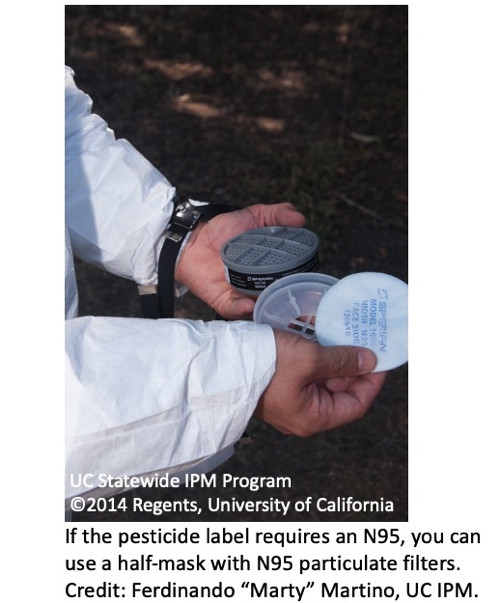
General PPE requirements: “Remember, the label is the law,” said Brim-DeForest. “PPE requirements for agriculture are not being loosened.” The UCCE advisor recommends purchasing only what you need for the season and choosing reusable PPE whenever possible. Growers who have excess supplies of PPE can coordinate with their county agricultural commissioner or UCCE advisor to help other producers in their area.
Respirators: If you can't find the respirator required on the label, Blecker said, “Use an alternative, more-protective respirator. For example, if an N95 is required, you can use a half-mask with N95 particulate filters; these can be stand-alone filters or ones that attach to an organic vapor cartridge. You could also use a different pesticide that doesn't require a respirator. Consult with your PCA (pest control adviser) for options.
”Gloves: Chemical-resistant gloves, usually 14 mil or more in thickness are required for most California pesticide applications and should be worn by mixers, handlers and applicators. If nitrile gloves are not available, viton and laminate gloves are universal chemical-resistant materials for most pesticide labels. If the glove material is specified on the label, that instruction must be followed.
“Disposable gloves less than 14 mil can be worn, but not for more than 15 minutes at a time, ”Blecker said. “Farmers should also note that thinner gloves cannot be layered on top of one another.”
Coveralls: Coveralls should be worn when required by the pesticide label or when the signal word is “WARNING” or “DANGER,” or when applying by backpack or airblast. “Coveralls can be made out of high-density polyethylene fibers (Tyvek and other brands), which are disposable, or cotton, which are reusable,” Brim-DeForest said. “If reusable coveralls are worn, the employer must ensure employees are provided clean coveralls.”
Goggles/face shields: Face shields are required for mixing and loading pesticides only if it's stated on the label. “If a face shield is unavailable, a full-face respirator can be used,” Blecker said. “Goggles or protective eyewear should always be worn in California when handling pesticides, regardless of what the label says. The face shield, goggles or safety glasses must provide front, side and brow protection and meet the American National Standards Institute Z87.1 standard for impact resistance.
For more information about PPE, contact your county agricultural commissioner or see the California Department of Pesticide Regulation's posters at:
https://www.cdpr.ca.gov/docs/whs/pdf/gloves_for_pesticide_handling.pdf and
https://www.cdpr.ca.gov/docs/whs/pdf/n95_alternatives_for_pesticide_handling.pdf.
UC IPM also covers these topics in their pesticide safety webinar series at:
http://ipm.ucanr.edu/IPMPROJECT/workshops.html.
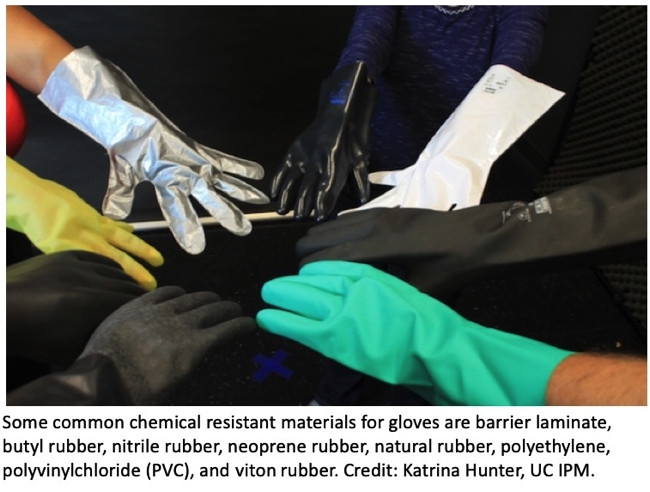
glove materials
Fire, Smoke, Ag Workers and Employers
California agricultural employers, workers approach smoke concerns differently
UC Davis examines health and safety awareness around mounting threat
University of California - Davis
In 2018, California wildfires burned more than 1.8 million acres and caused smoke to drift hundreds of miles. As the frequency and intensity of wildfires increases with climate change, California agricultural workers are at greater risk of smoke exposure as they often have no option but to work outdoors.
A new study from researchers at the University of California, Davis, finds that while wildfires and smoke exposure are recognized by farmworkers and employers as a growing threat and safety concern, the means to address these concerns differs between the two groups.
"What stood out in this study is the substantial disparities between agricultural employers and farmworkers," said Heather Riden with the Western Center for Agricultural Health and Safety at UC Davis.
Riden, who led the research in partnership with the California Institute for Rural Studies, said that while growers and employers expressed concern about poor air quality at the time of the study in 2018, many had no clear plans or protocols for measuring air quality or managing workers in such conditions. While the public is advised to stay indoors due to poor air quality during a wildfire, agricultural work often continues.
The study also found that when farmworkers were offered protective masks, many found them difficult to use while working due to heat-related discomfort and chafing. Others believed wearing two bandanas over the mouth and nose would provide just as much protection.
Farmworkers' experience is compounded by economic need.
"Many farmworkers will continue working, even in unsafe conditions, to support their families. They don't have many other options," said Riden.
NEW REGULATIONS
Last year, the state Division of Occupational Safety and Health, better known as Cal/OSHA, enacted an emergency regulation requiring employers to take measures to protect workers from wildfire smoke when the Air Quality Index reaches 151 or greater, which is considered unhealthy. Riden said as CAL/OSHA begins to craft permanent regulations, she hopes it takes the study's findings into consideration.
"This highlights the need for better awareness for both agricultural employers and farmworkers about the health risks associated with wildfire smoke," said Riden. "Employers also need training materials and concrete steps they can take to protect workers."
To assist agricultural employers with meeting the requirements outlined in the newly adopted regulation, the Western Center for Agricultural Health and Safety developed training materials and an employer checklist.
###
The study was based on interviews and focus groups with California agricultural employers and workers in the Salinas, San Joaquin and Imperial valleys. Support for the study came from the Centers for Disease Control and Prevention, and the National Institute for Occupational Safety and Health.
For the complete article and amazing pictures check out: https://www.ucdavis.edu/health/california-agricultural-employers-workers-approach-smoke-concerns-differently
Media Contact
Amy Quinton
amquinton@ucdavis.edu
530-752-9843
@ucdavisnews
This content was developed by the Western Center for Agricultural Health and Safety at UC Davis. For more information and to access their wildfire training materials, visit their wildfire training page: https://aghealth.ucdavis.edu/wildfires
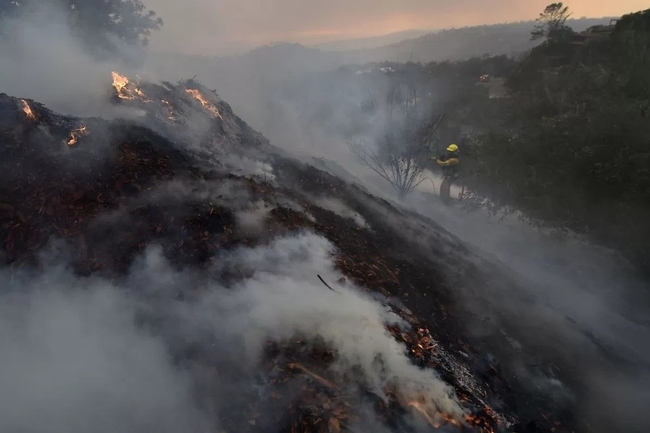
fire hillside


